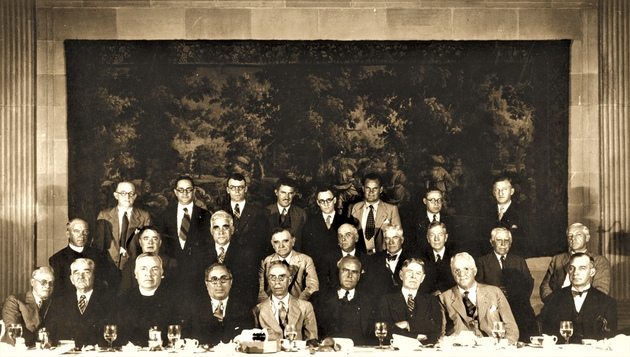
In the late ’20s, Hollywood was under fire from Catholics for making immoral movies. Film moguls had good reasons to respond when Loyola University’s president invited them to dinner to discuss his university’s future.—The Editor
In September 1928, Joseph A. Sullivan, S.J., president of Loyola University, sat down with some of the most powerful movie moguls and businessmen of the era for a fundraising dinner to benefit the construction of a new college campus on the bluffs of Westchester.
For much of the last half of the ’20s, Hollywood had been under fire from Catholics for making immoral movies. Film moguls had good reasons to respond when Loyola’s president invited them to discuss his plans. Among the guests were Winfield Sheehan, chief of production for Fox Film Corp.; Louis B. Mayer, of MGM; George Eastman, of Kodak-Eastman; Harry Langdon, silent film star; Harry Chandler, publisher of the Los Angeles Times; and Fritz B. Burns, real estate developer and philanthropist. (See below for a list of those pictured.)
On that night, Sullivan was two years into a brief but enormously influential four-year term as president of Loyola University. On that night, he took a daring step by reaching out to Hollywood’s highest levels. The film industry was reeling from criticism over immoral content, with some of the strongest barbs coming from U.S. Catholic leaders. The companies also were immersed in a fierce struggle to decide the system of sound that would be the industry standard for “talkies.” And from the mid- to late-1920s, they were scrambling to buy land for large studios in the Los Angeles area. One could say it was nearly an act of grace that the members of this group broke bread together.
Censorship would continue to loom over Hollywood, but Fox won the sound battle with its Movietone technology, which allowed true synchronization of sound and pictures. In March 1929, Fox distributed a trailer called “A Live Wire,” one of the first talkies using Movietone. “A Live Wire” promoted the Screen Stars Gambol, a benefit show for Loyola University featuring a panoply of stars from all the studios, including Al Jolson, on April 1, 1929, at the Shrine Auditorium. Tickets were $10.
The Head Table
Loyola University’s September 1928 dinner brought together more than 150 of the most influential figures in Los Angeles. A select group, most of whom need no introduction even today, sat at the head table.
Back row, left to right: John A. Van Kuik, William Bearman, Fritz B. Burns, Frank M. Flynn, Edward C. Purpus, Frank Muller, Harry Langdon and James J. Donahue. Middle row, left to right: Father W.E. Corr, Winfield Sheehan, Joseph Scott, Isidore B. Dockweiler, John G. Mott, Supervisor John H. Bean, Rev. Edwin P. Ryland, R.F. Del Valle and Judge Benjamin F. Bledsoe. Front row, left to right: Samuel T. Clover, E.P. Clark, Loyola University President Joseph A. Sullivan, S.J., Louis B. Mayer, Judge Louis W. Myers, George W. Eastman, George I. Cochran, Harry F. Chandler and John G. Bullock.
(Photo courtesy of the William H. Hannon Library Archive and Special Collections)
